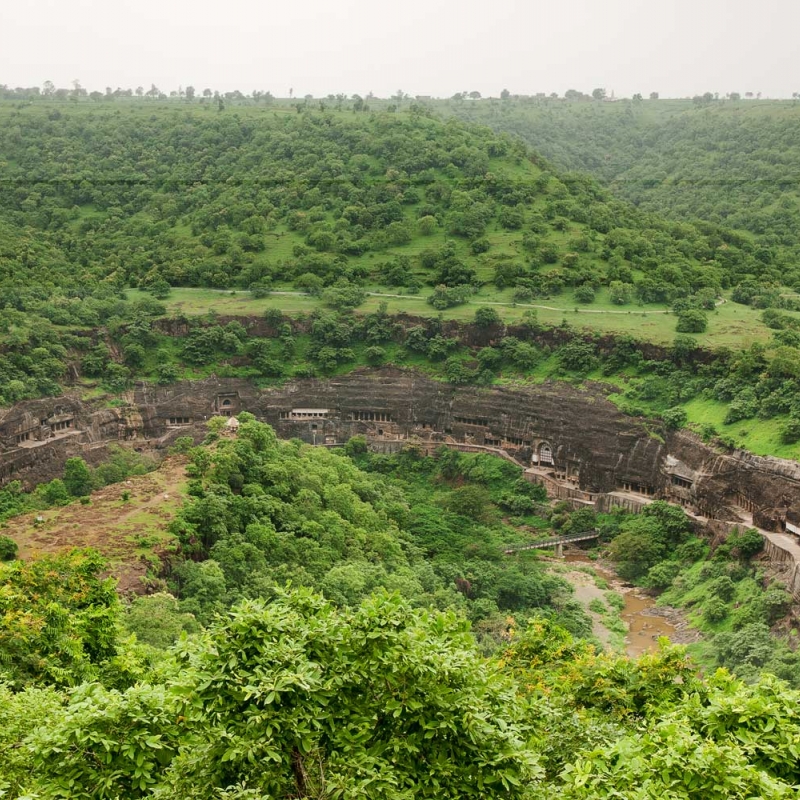Contents
Introduction
There are about 1200 rock-cut caves in India, of which 1000 are in Maharashtra, and of these nearly two-thirds are Buddhist. Earlier scholars, particularly Fergusson and Burgess, have broadly classified these under the rubrics Hinayana and Mahayana, based on the absence or presence of the Buddha image, and dated them to about 200 BCE–200 CE and 500–1200 CE respectively, with a hiatus in between (Fergusson and Burgess 1880).[1] In many caves, Buddha images were added later, in 600–800 CE. However, a very pertinent question has recently been raised: Is there a Mahayana at Ajanta (Singh 2012:34–37)? At the root of this query is Gregory Schopen’s article on Mahayana (Schopen 2004). He writes:
Textual sources placed the beginning of Mahayana in the second century CE with the first translation of Lokakshema’s Sukhavati-vyuha-sutra which is central to the Mahayanists. The evidence outside the textual corpus does not corroborate the conclusion that Mahayana started around the beginning of Common Era. The principal reason is the utter lack of inscriptional and archaeological records in support of such a conclusion. There is just an isolated inscription and an image depicting Amitabha, the deity most central to Mahayana during the whole period of five centuries. The inscriptions refer to Hinayana groups: the Sarvastivadins, Mahasanghikas and Chetiyas etc. Thus it was not the period of Mahayana but of Hinayana. (Cited in Singh 2012:34–35).
Mahayana Buddhism
Broadly, Buddhism is divided into three schools: Hinayana, Mahayana, and Vajrayana or Tantric Buddhism. The beginning of Mahayana Buddhism goes back to the second to first centuries BCE and some would trace it to the fifth century BCE in the nikayas in the first Buddhist Council which was organized at Rajagriha (Rajgir in Bihar) to discuss the Buddha’s teachings which had not been committed to writing till then. It is said that even the Buddha is supposed to have had philosophical leanings towards Mahayanism. The Second Council was held at Vaishali (Bihar) in 386 BCE, where the differences between the bhikshus, though minor, came into the open for the first time and the first schism occurred. One group was that of the traditionalists (Sthaviravadins or Theravadins), and the other that of the Mahasanghikas, who held opposite views. The Theravadins therefore excommunicated the Mahasanghikas, so named because they were powerful due to their majority; the latter branded their opponents as Hinayanists, or 'Lesser Vehicle' (Dutt 1988:79). The Mahayana school was firmly established when the Madhyamika school of Nagarjuna, and the Yogachara of Maitreyanath, Asanga and Vasubandhu came into being.
The Hinayanists believed in the four Aryan Truths (chatvari arya-satyani), the eight-fold path (marga), and the chain of causation (pratitya-samutpada). The Mahayanists seek the realization of dharma-nairatmya which may mean five elements (skandhas). In Mahayana nirvana is individualistic; it is an eternal state, powerful and happy, and is attained by eradication of impurities caused by ignorance. A.K. Coomaraswamy has cogently brought out the differences between the Hinayanists and the Mahayanists:
The Mahayana or the Great Vehicle offers to all beings in all worlds salvation by faith and love as well as by knowledge, while the Hinayana only avails to convey over the rough sea of becoming to the further shore of nibbana those few strong souls who require no external spiritual aid nor the consolation of worship. The Hinayana is exceedingly hard whereas the burden of Mahayana is light and does not require that man should immediately renounce the world and all the affections of humanity (Coomaraswamy 1956:228–29).
The adherents of the Mahayana sect are known as Bodhisattvas who are instructed to become Buddha ultimately. In other words, they reject the idea of Arhathood so dear to Hinayanists, but aim at Buddhahood through Bodhisattva state as it helps others to achieve salvation. Hence, there are past and future Buddhas in Mahayana Buddhism. Finally, the most important difference is the image worship which was introduced with meditation as also elaborate rituals, formulae, charms and belief in heavens. The Mahasanghikas found support in Maharashtra, where Karle was their stronghold, and Andhra Pradesh (Gokhale 1976:90).
The differences between the Hinayanists and the Mahayanists were no doubt sharp but the issue is how they are reflected in art. The trends followed by the Hinayanists consist of absence of Buddha image in visual representations, symbolic worship and the occurrence of the words deya-dhamma in their donative records. So far as the Mahayanists are concerned we can expect: (i) images of Buddha and Bodhisattvas whom they accorded a higher status than that to the Enlightened One; (ii) a room for mediation; (iii) Manushi Buddhas; (iv) narratives according to the Avadana stories, and (v) the Mahayana formula of the donative record wishing happiness and well-being of all. It was probably due to Avalokitesvara’s insistence that he would not accept salvation until all beings attained it.
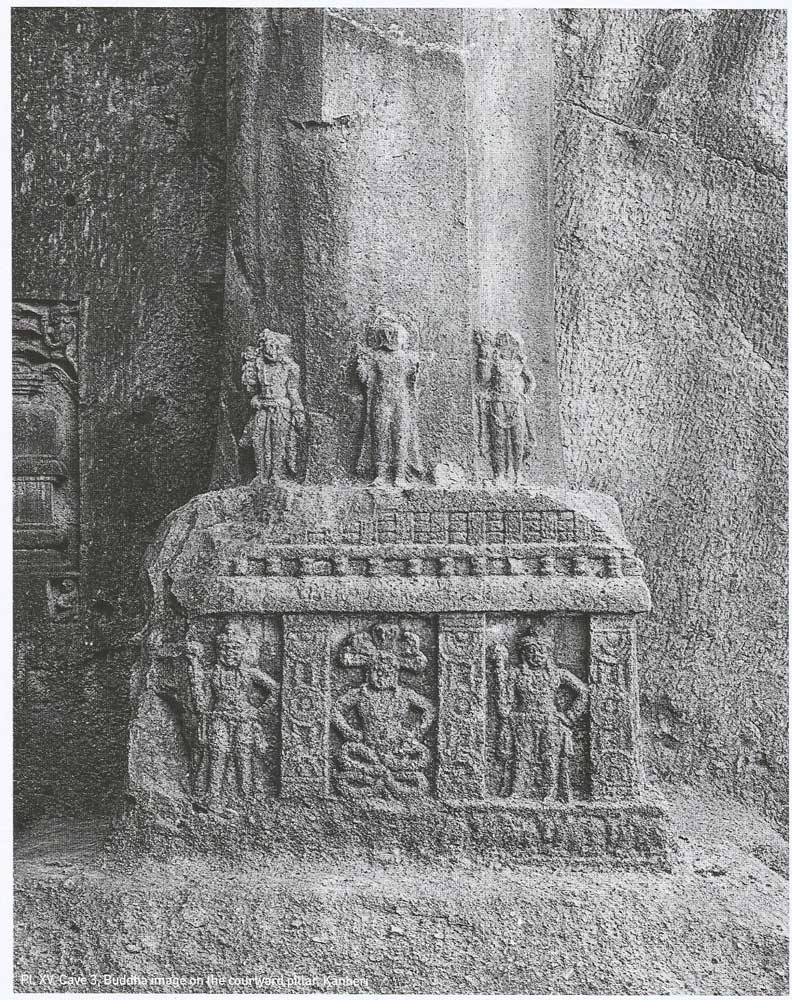
Fig.1. Kanheri chaitya Cave 3, forecourt: Buddha figures on the pillar
The broad classification made by earlier scholars was simple and there was a hiatus of about four centuries between the Hinayana and the Mahayana rock-cut caves, but this gap is narrowed by the earlier chronology proposed by Spink who assigned the later group of caves at Ajanta to about 460-480 AD (W. M. Spink 2005–14). It is averred that the Mahayana school was till then in the formative stage and therefore Schlingloff argues that there is no Mahayana at Ajanta (Schlingloff 2013:75). This, however, is not tenable as it has been observed that the Mahayana elements were already present even in the second century. Buddha images were already present in the late second century at Amaravati, and in the early third century two Buddha images were carved—rather stealthily and not to be easily seen by the visitor—on the huge right pillar in the forecourt of Chaitya cave 3 at Kanheri (Figure 1), the lower one standing and the upper one seated (Leese 1979). Yet another, an unfinished one, is on a pillar of the apsidal chaitya hall. Although Buddha image is not taken to be the monopoly of the Mahayanists, it is clear that it appears only with the rise of Mahayana. The earliest Buddha/Bodhisattva image carved in the second year of Kanishka’s reign (79 CE) is in the Sarnath Museum. The Kanheri chaitya is dated to the last quarter of the second century on the basis of an inscription in it which states that the donation was made in the sixteenth year of the reign of Yajnasri Satakarni (170–99 CE). This epigraph also states that ‘the grant was given for the happiness and welfare of all’ which is the Mahayana formula, and not deya-dhamma, of the Hinayana tradition (S. Gokhale 1991, inscr. # 5). There are a few earlier records at Junnar in which we come across the Mahayana formula (Dhavalikar 1984:24, n. 4). Meditation chambers first occur at Junnar and a little later at Kanheri.
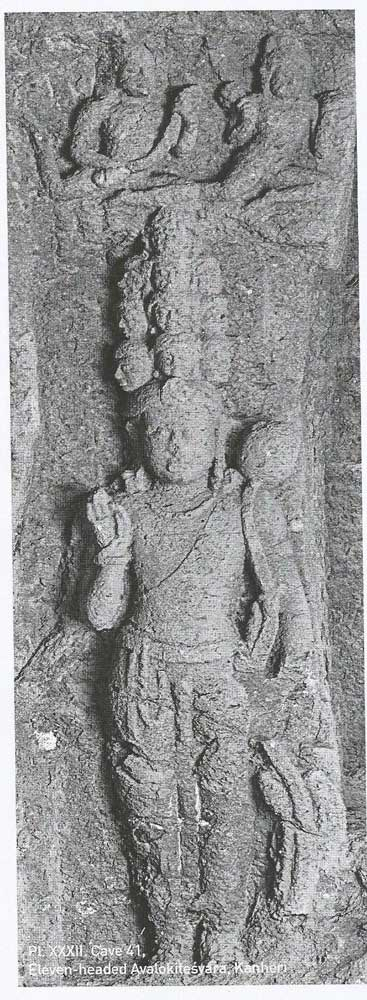
Fig.2. Kanheri cave 41, eleven headed Bodhisattva
Again at Kanheri the domination of Mahayana is clear from Avalokiteshvara images such as the eleven-headed litany of Bodhisattva (three panels) (Figure 2), with Tara and Bhrikuti, and above all Akshobhya in Cave 41. At Ajanta too there are Avalokiteshvara images in painting and sculpture as well, his litany, and Manushi Buddhas which all indicate the presence of Mahayana at Ajanta which Spink places in the fifth century. In this context I-Tsings’s observation is significant.
Priests and laymen in India make chaityas or images with earth or impress the Buddha image on silk or paper, and worship it with offerings wherever they go. Sometimes they build stupas of Buddha by making a pile and surrounding it with bricks. They put in the images or chaitya of two kinds of sariras: (1) Relics of the Great Teacher, (2) The Gatha of the Chain of Causation. [ (Takakasu 1896:150–52)]
It is likely that at Ajanta the Mahayanists may not have been dominant as at Kanheri and Ellora where even Vajrayana influence is discernible. The reason for this is that at most of the Buddhist cave monasteries in Maharashtra, both the Hinayanists and Mahayanists, were living amicably together as testified by I-Tsing. And this is probably the reason why Schlingloff is not very emphatic in spite of the fact he has identified some of the narratives on the basis of Avadana stories which are Mahayanist. He states:
The majority of narrative paintings are based on the Vinaya of the Mula-sarvastivadin, and on the poems of Aryasura and Asvaghosha (Saundar-ananda). All the works of literature connected with the paintings belong to the Hinayana, and accordingly, themes that are particularly ‘Mahayanistic’ were not portrayed with the possible exception of the Avalokitesvara’s devotional pictures. The term Mahayana for the later caves, which originates from the time when the literary background of the paintings was still unknown, can therefore only be used as a label, it would be a mistake to form a conclusion about the ideology behind the paintings on the basis of this term. [ (Schlingloff 2013, vol. I, 75)]
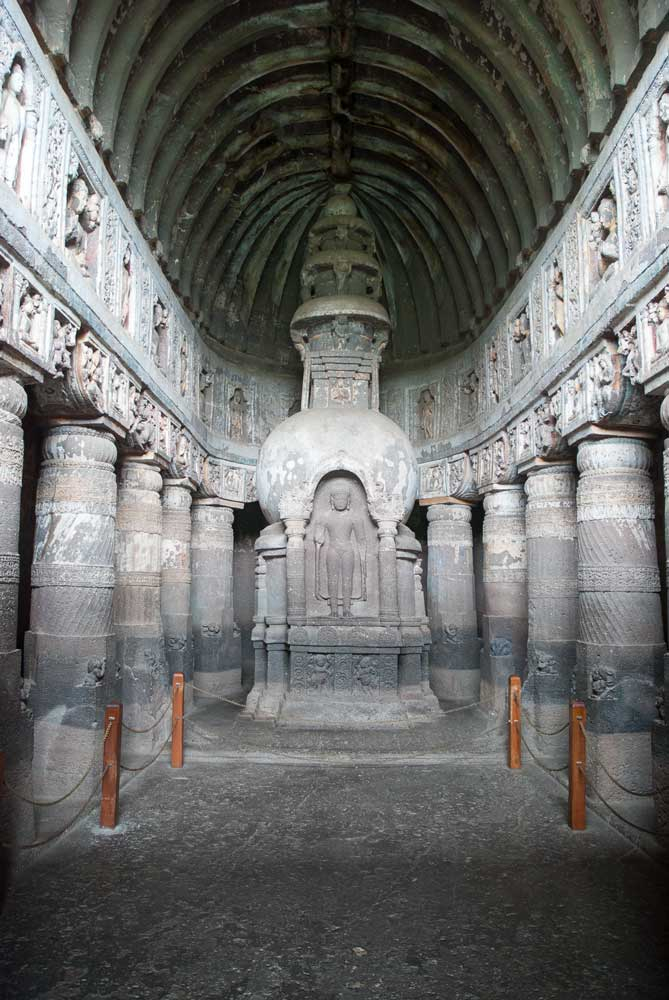
Fig.3. Ajanta chaitya 19, hall with Buddha image and the stupa
Since the Mahayana affiliation of Ajanta is a crucial issue, it is better to analyse the textual evidence and collate it with that of the art and architecture of the caves. The final products at Ajanta are the chaityas 19 and 26 in which we find stupas with Buddha images carved on their front (Figure 3). This is a great leap from Hinayana stupas and the problem therefore deserves to be examined threadbare. The early Hinayana chaitya is apsidal in plan which is divided into central nave and side aisles by plain octagonal pillars, with rock-cut stupa in the apse; it has a huge arch on the façade. There is major deviation in Ajanta chaitya 9 which is quadrangular in plan but the pillars are disposed in an apsidal fashion (Figure 4). Interestingly, Aurangabad 4, a chaitya, is also identical. Similarly Kanheri cave 7 is quadrangular in plan but the post-holes in the hall are in the apsidal fashion. This is probably the earliest cave that was excavated at Kanheri and was in all likelihood meant for the residence of monks supervising the work; the apsidal portion was for their religious activities. These early examples indicate that the change in Ajanta 9 may not have been accidental but rather by design.
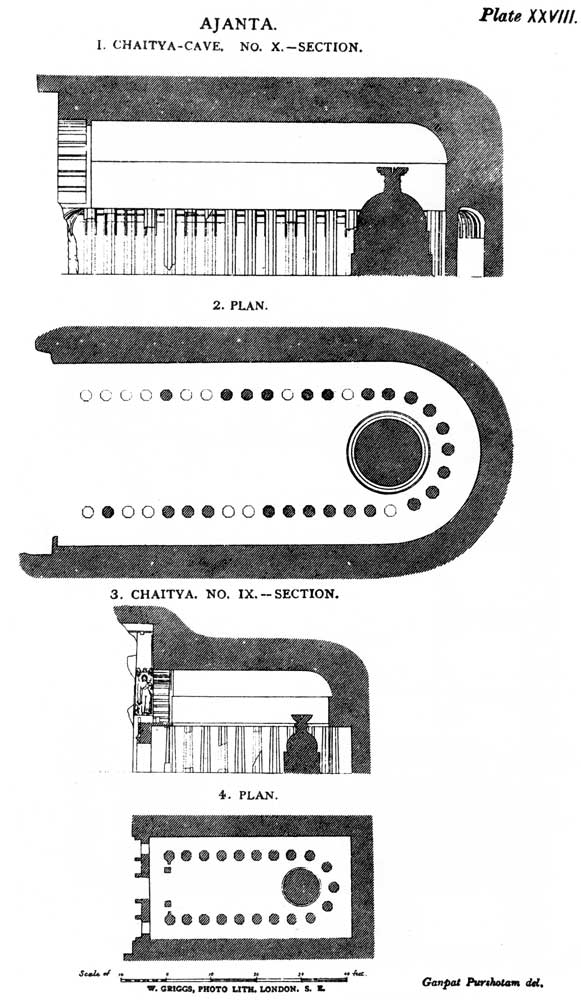
Fig.4. Ajanta 9, plan
Junnar
Further development takes place at Junnar which, with 105 caves, is probably the largest Buddhist complex, next to Kanheri, but dispersed in different groups. Here Ganesh Leni 6 is a standard chaitya conforming to the Hinayana plan but the chaitya arch is blind. This was not done deliberately but there was no alternative because of a loose stratum of rock. The same was the case with Amba-Ambika 26 of which the hall is not exactly apsidal but rather irregular. From this seems to have developed the quadrangular chaityas at Junnar, for instance, Bhimashankar 2, Ganesh Leni 14 (Figure 5), Shivaneri East 2 and so on. The apsidal and vaulted roofed chaitya now becomes quadrangular, astylar and flat roofed (Dhavalikar 1984, 12 ff.).
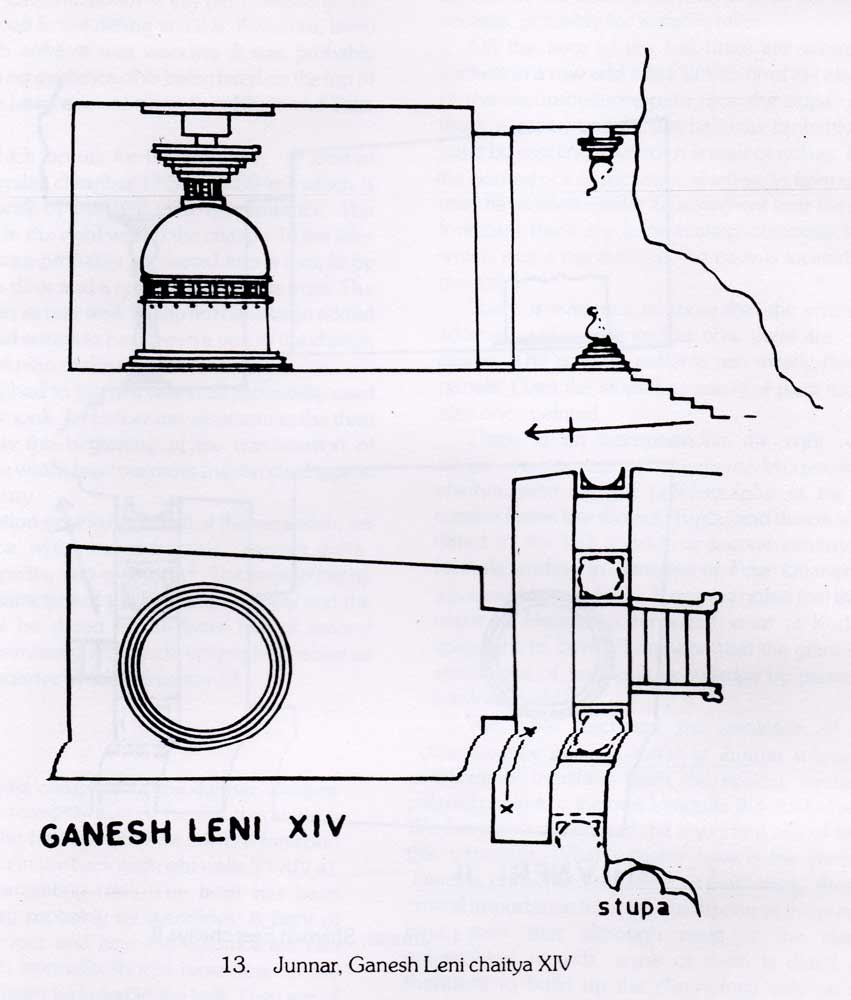
Fig.5. Junnar Ganesh Leni 14, plan
This happened in the mid-second century when the Western Kshatrapas had pushed the Satavahanas into the southern Deccan and the rulers were not worried about changes in the religious architecture which otherwise would have been blasphemous. The artists therefore had some freedom to experiment their novel ideas. But in the latter half of the second century the Satavahanas again assert their domination in Maharashtra under the leadership of Yajnasri Satakarni (170-99) when the impressive Chaitya 3 at Kanheri was excavated. It is the last standard Hinayana chaitya because the decline of the Satavahanas created political instability and economic degeneration resulting in decrease in long distance trade which affected the art activity. This is the most important reason for the hiatus between the Hinayana and the Mahayana caves in Maharashtra when the art activity came to a grinding halt and picked up again only in the fifth century, see Sharma 1987 and Dhavalikar (2002:192 ff.).
All these early caves are Hinayana monuments but it seems that Mahayana elements were already being introduced. The donative inscription in Shivaneri East 4, which is engraved on the right wall of its forecourt, mentions that it was donated by a merchant named Virasenaka for sava-loka-hita-sukhaya which indicates Mahayana influence (Burgess 1883, 93), and the same is the case with that in Kanheri chaitya 3 which ends with savvasa-cha-hita-sukhaya (S. Gokhale 1991, inscr. # 53).
Kanheri
There are three early Buddha figures in the Kanheri chaitya 3. Two of them are carved on the right (south) pillar in the forecourt and are taken to be the earliest anthropomorphic representations of the Enlightened One in Western India as they can be assigned to the early third century. The lower one is shown standing and the upper one is seen seated in meditation (dhyana-mudra); his right hand displays the granting-protection gesture (abhaya-mudra) (Figure 1). The chaitya 3 can be assigned to the end of the second century on the basis of an inscription in it belonging to the period of Yajnasri Satakarni (170–99); the work on the forecourt and the pillars in it were probably carved a little later as its northern wall is not in alignment because of the adjoining memorial chaitya 4 which had to be excavated first even while the work on Chaitya 3 was underway (Dhavalikar, In press).
There is yet one more Buddha figure on the base of the fifth pillar from the front on the left. It is unfinished and may have been intended to be Buddha. Besides this, one epigraph in this chaitya recording the gift ends with savacha-hita-sukhaya which is clearly the Mahayana formula. There is another example of this kind and there is therefore little doubt that Mahayana influence had started filtering into Maharashtra in the mid-second century.
Equally important is the new vihara at Kanheri which was probably the largest Buddhist establishment in Western India with about 115 excavations. They can be divided into three different phases: (i) Hinayana, 150-200 AD (ii) Early Mahayana, 200-350 AD (iii) 450-700 AD. It is surprising that in such a vast complex there is only one chaitya (No. 3) and not a single chatuhsala vihara of the standard Hinayana type. All the remaining viharas are laid out according to the new plan which is not to be found at any other Buddhist site in Maharashtra. The Kanheri architects devised a new plan which basically consists of a square hall with a veranda at the front and a well-made forecourt. The hall has benches along its walls and small cells for worship and meditation. This simple plan resembling small bungalows at holiday resorts, further develops in course of time with additions such as pillars in veranda, recessed doorframes, stairs with moonstone (chandra-sila), and above all sanctum in the rear wall. Almost every cave has a water cistern. The Buddha and Bodhisattva images were added later in the fifth-sixth century AD.
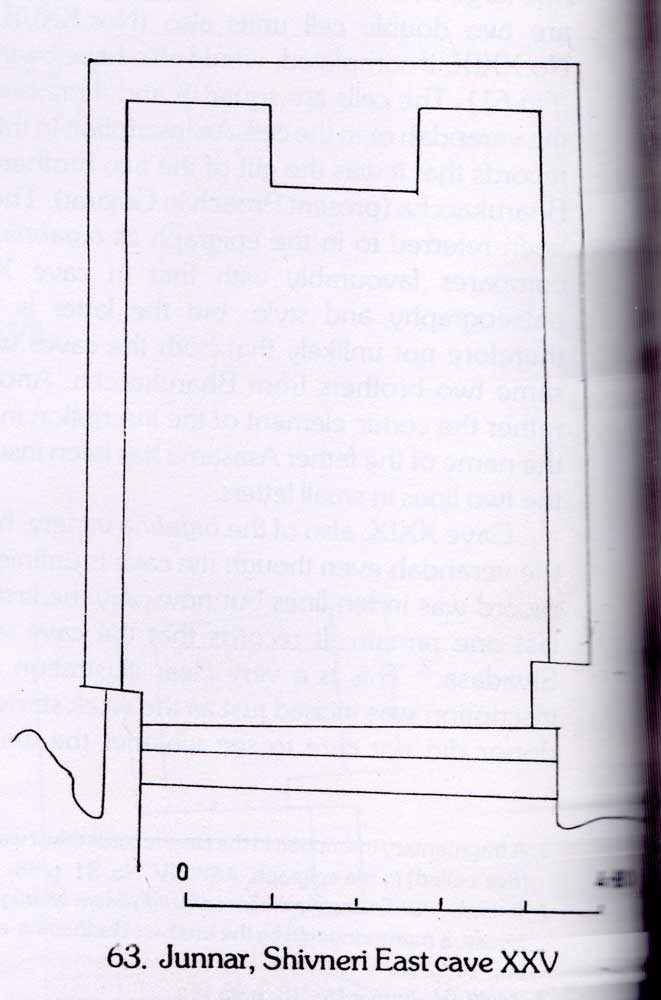
Fig.6. Junnar Shivaneri East, 25, plan
The origins of this new vihara plan can be traced at Junnar which is at a walkable distance from Kanheri through the Nanaghat Pass. We have shown how the apsidal, vaulted roofed chaitya evolves into a quadrangular and flat roofed one at Junnar. In the Tulja Leni group at Junnar Cave 13 there is a roughly square hall with benches on three sides and a small cell in the left wall; its front, however, is completely ruined (Dhavalikar 1984, 12 ff.). The Shivaneri East 25 (Figure 6) is also a quadrangular hall with benches on all sides except at the front, and there is a projection in the middle of the back wall which may be for the chief monk or for placing the object of worship. But these are just halls (mandapas) for congregations, and there are other examples such as Bhimashankar 2 and Amba-Ambika 27 and 28 which also are just square halls with verandas at the front.[4] It may be noted that these are purely Hinayana examples as is clear from the dedicatory formula of epigraphs in them. This plan appears to have been adopted at Kanheri with slight modifications. It is not unlikely that after the close of work at Junnar, the artisans came to Kanheri. Another important factor was that such experiments in religious architecture could be carried out without much difficulty because of the rule of Western Kshatrapas who were of foreign origin.
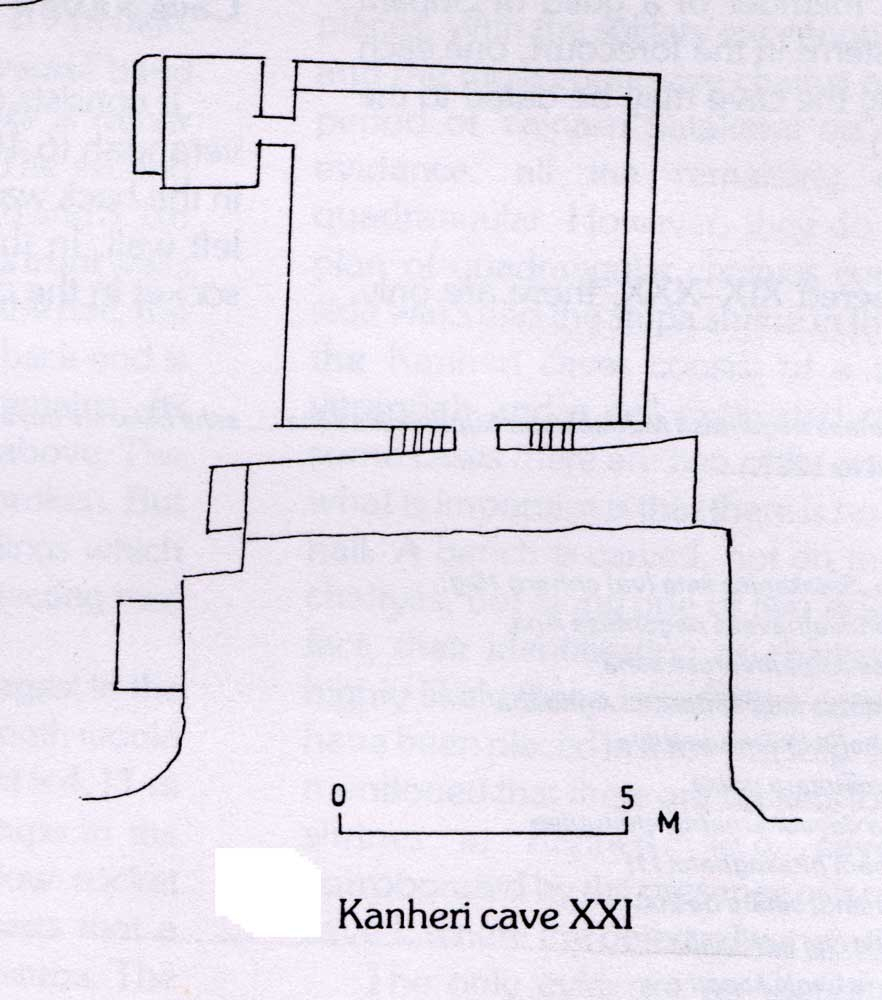
Fig.7. Kanheri 21, plan
In the second group (200-350 AD), the first cave that was excavated according to the new plan is No. 21 at Kanheri which can be assigned to about 200 AD as it was excavated in the 16th regnal year of Yajnasri Satakarni (170-99), and is thus contemporaneous with the Chaitya 3 (Figure 7). The cave 21 consists of a square hall (6 m sq.) with a veranda and a well-made forecourt. The hall has benches in the rear and right walls and a small cell in the left hand corner at the back with a bench. The veranda also has a bench in the left wall and the entrance to the hall is flanked by grated windows. There is a recessed cistern in the forecourt in the left wall above which is an inscription which records the donation by Aparenu, a resident of Kalyan, with his relations, which was given on the fifth day of the Grishma season in the sixteenth year of the reign of Yajnasri Satkarni, i.e. 186 AD. The donation was made to the Sangha of four quarters, Kanhasele lenam kodhi cha deyadhammam chatudise bhikusanghe savasatanam hitha sughata, line 8 (Burgess 1883, Junnar).
This record is of key importance in as much as it explicitly mentions deyadhammam, the Hinayana formula and also monks of the four quarters as also sarvva-satvanam-hita-sukha, which is the Mahayana formula. And above all it can be firmly dated to 186 AD. The record is thus unique as it is the first document indicating the advent of Mahayanism in Western India. The Buddha images on the courtyard pillar is also assigned to the reign of Yajnasri. Much time therefore must not have elapsed between the chaitya and the Buddha images in Cave 3.
Cave 22 is almost identical but has, in addition, a staircase and so is the case with No. 26, the stair of which has a chandrasila. It also has a small niche in the back wall which, however, is a later addition as it contains a Buddha image. The dedicatory epigraph displays developed forms of letters having ornamental flourishes suggesting a third century date.
Caves 49-70 conform to the standard type evolved at Kanheri, and belongs to the first half of the third century. There are minor variations but for the Buddha sculptures of the fifth-sixth century.
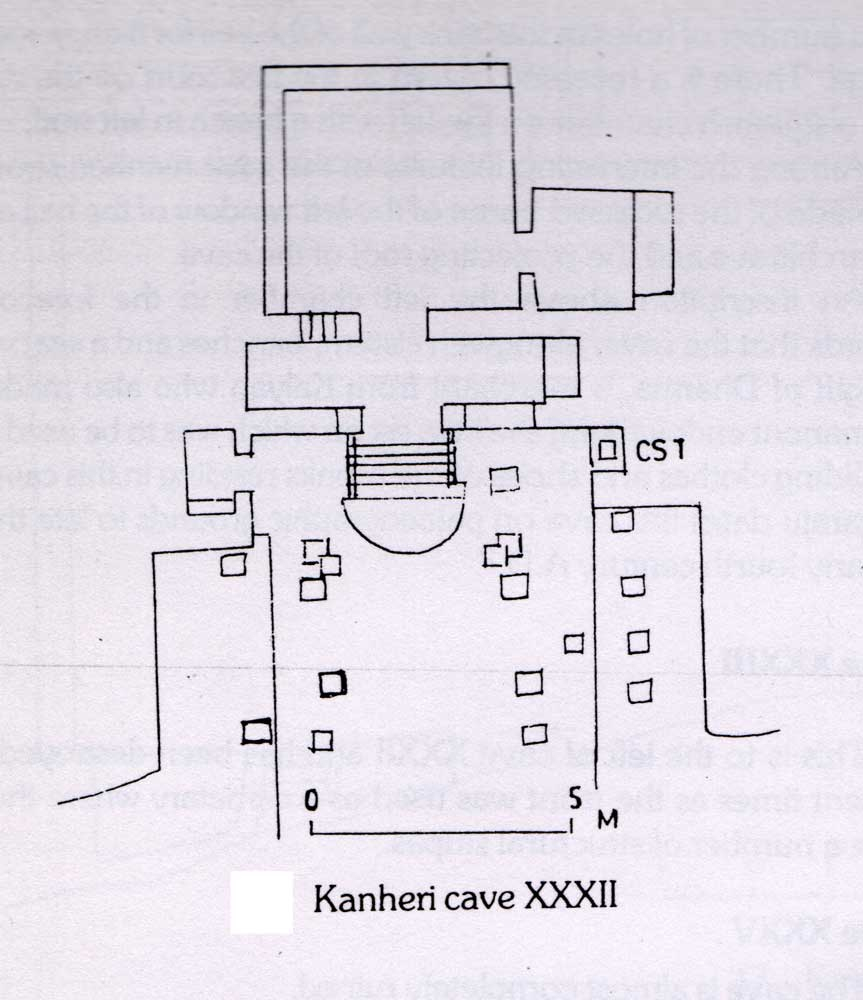
Fig.8. Kanheri 32, plan
Cave 32 is a well-planned and meticulously excavated vihara with a spacious forecourt having holes for wooden posts supporting a canopy that may have been erected on special occasions (Figure 8). The veranda has octagonal pillars with square bases and the pilasters have hour-glass decoration, as also benches which are adorned with vedika rail pattern on the back. The square hall (4 m sq.) has a bench in the rear wall and a cell with bench in the right wall. The discovery of a wooden image of Tara in this cave is its important feature for it shows that loose images were worshipped in the new viharas (Sankalia 1986).
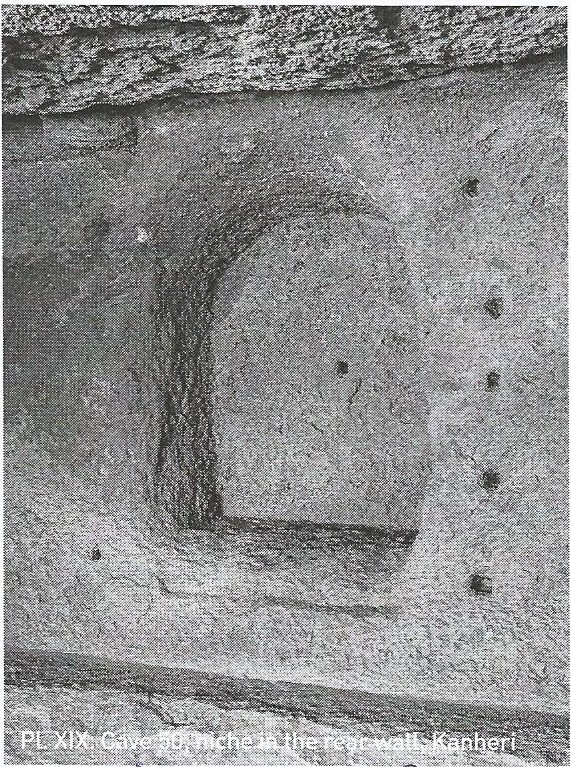
Fig.9. Kanheri cave 50, niche in the rear wall
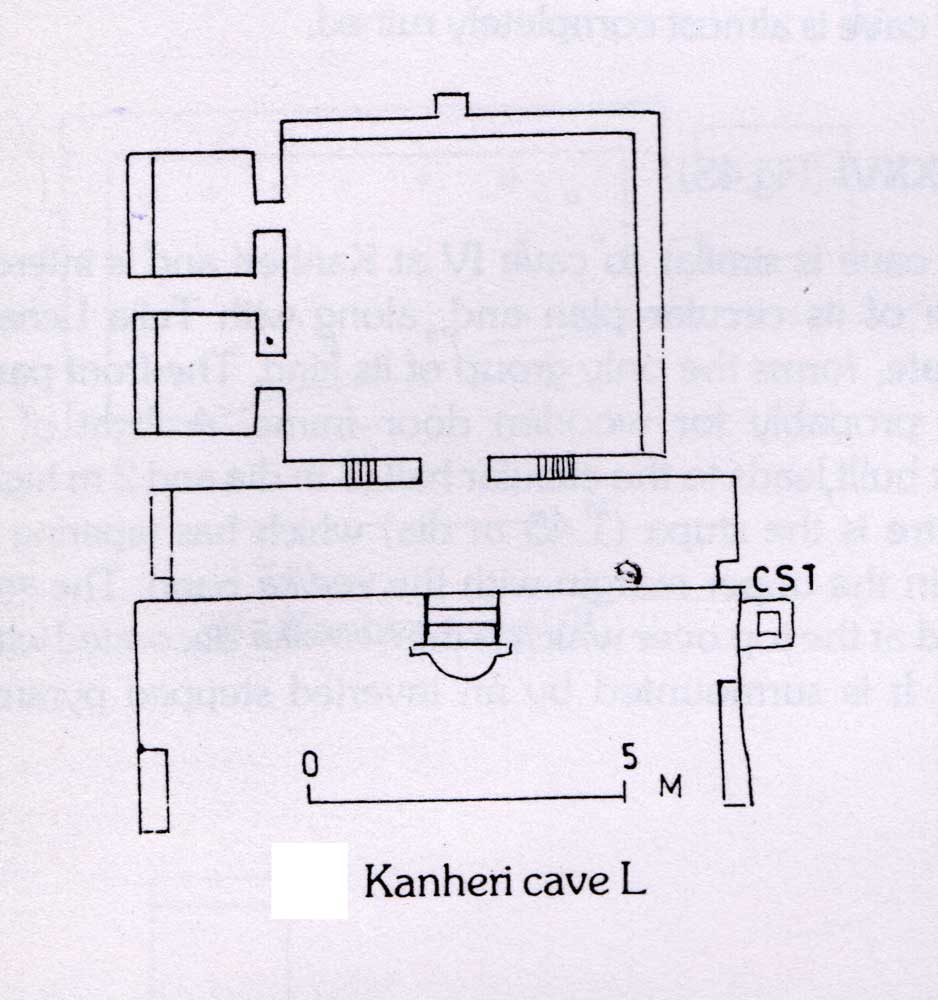
Fig.10. Kanheri 50, plan
Cave 50 marks a further development as it has a niche in the rear wall surrounded by holes possibly for lamps or for some wooden attachment for the object of worship which obviously was portable (Figures 9, 10). The cave has two cells in the left walls and a running bench in the rear and right walls. Another noteworthy feature is the absence of pillars in the veranda but the pilasters bear the hour-glass decoration which later fully develops at Ajanta into medallions of great beauty. The cave can be dated to the late third or early fourth century on the basis of the palaeography of the record which resembles the Kadamba or early Pallava inscriptions. It mentions the gift of a perpetual endowment of 1600 karshapanas by stone masons of Kallivana (present Kalwan near Nasik). A wealthy trader, Sulabhati, among them, repaired the washed away road to the vihara while his relations donated the benches for two monks who were living in it.
There appears to be a hiatus of about a century (350-450 AD) between the Early and Late Mahayana groups at Kanheri. Politically this period was marked by instability, and the economic activities were also on the decline as trade with Mediterranean countries was reduced to a dribble. The local chieftains like the Maharathis and Mahabhojas do not mention their overlords, as for instance, Kuda inscriptions of the Mandava family. It was only from the mid-fifth century that the activities pick up again with the Vakatakas gaining supremacy. As a matter of fact the post-Satavahana epoch is marked by degeneration in all fields of human life. At Kanheri the new standard plan continued with minor variations and at other places small caves were excavated, but many of them have remained unfinished possibly due to lack of patronage. The activity continued at Kanheri because of the ports of international trade such as Sopara, Chaul, Kalyan etc. in its vicinity. In such an unstable environment it is surprising that small bungalow like viharas were created at Kanheri. They are all Mahayanist with images of Buddhas and Bodhisattvas, Avalokiteshvaras with their litanies, Tara and Bhrikuti, and above all, the Dhyani Buddhas which herald the advent of the Vajrayana Buddhism. Kanheri perhaps is the only stronghold of Mahayana Buddhists in Western India except at Ellora which again represents the Mahayana–Vajrayana transition.
The high water mark of Mahayanism at Kanheri is Cave 41. Located on the south side of the stream, it has a pillared veranda. The hall has no benches but a cell in each of the side walls of which the central one is the shrine containing a seated Buddha in the teaching attitude (vyakhyana-mudra). The side walls of the hall are profusely decorated with sculptures, mostly showing Buddha seated, which probably is the delineation of the Miracle of Sravasti that he is supposed to have performed.
The cave follows the standard plan devised at Kanheri but is later (6th cent.) with pillars having cushion capitals and square shafts in the lower part. The doorframe of the hall is recessed and is carved with the vase motif (purna-ghata), the symbol of prosperity. The lintel is adorned with five arches. The shrine has Buddha in the dharma-chakara-pravartana-mudra. He is flanked by attendants of whom that on the right is Avalokiteshvara. In the right end of the veranda is Buddha in meditation with attendants. On the left is a unique representation of the eleven-headed Avalokiteshvara which is the only one of its kind in India. The image in the shrinelet in the forecourt is, in all likelihood, Amitabh in meditation. The earliest mention of Amitabh is to be found in the Sukhavati vyuha and he is also known as Amitayus. He is said to be residing in heaven where he is constantly in meditation. He is supposed to have brought forth Avalokiteshvara.
Bodhisattva Avalokiteshvara is the most exalted divinity of Mahayana Buddhism and occupies a higher position than that accorded to Buddha. He prominently figures in the Saddharma Pundarika and the Sukhavati Vyuha which describe him as far superior to other Bodhisattvas; only Manjusri is his equal. The lotus and rosary are his attributes, making him comparable with Brahma and Vishnu. He is the only Bodhisattva who is shown with four arms (not even Buddha) which carry the attributes of Brahma viz. rosary, lotus and kundika (water vessel), and the fourth hand is in varada mudra. The idea of Avalokiteshvara goes back to the third century BC, during the time of Ashoka. It was originated by the Mahasanghikas in their Mahavastu Avadana whereas the images came to be made from the early first century AD.
It will thus be clear that the Mahayana phase in Western India starts from the last quarter of the second century when a new form of vihara was introduced as is exemplified by Cave 21. Although it looks like a small compact residence, it could provide accommodation to a number of occupants at a time because of the running benches in side walls. Another advantage was that the benches and small cells in the walls were more useful for keeping the object of worship, a stupa or an image like that of Tara which was found in Cave 32. The planning of the viharas at Kanheri has elicited high praise from discerning critics:
More than any such monastic establishment in India, that at Kanheri displays an order and refinement at a place for multiple residences. Each cell shows a natural but considered siting which produces a living environment (for monks in the monsoon) that could be well emulated by planners today. [ (Meister 1981, 163)]
The religion was undergoing a paradigm shift in the beginning of the Common Era with the rise of the Mahayanists, but although there was rivalry among them and the Hinayanists, in Western India the adherents of both of them were living amicably as found by I-Tsing.
Kuda
When the Mahayanist influence was being felt at Kanheri, changes were being introduced in the layout of the chaityas at other centres, as for instance Jakhinwadi. These were small excavations as patronage had almost dried up for imposing chaityas like that at Karla. The most noteworthy site of this change is Kuda (district Raigad) on the western coast which has a complex of 28 caves datable to the third century on grounds of palaeography. Many of them were donated by a family of four brothers and their wives. They themselves were writers and the inscriptions engraved are probably the most beautiful records as they can be read like sign boards.
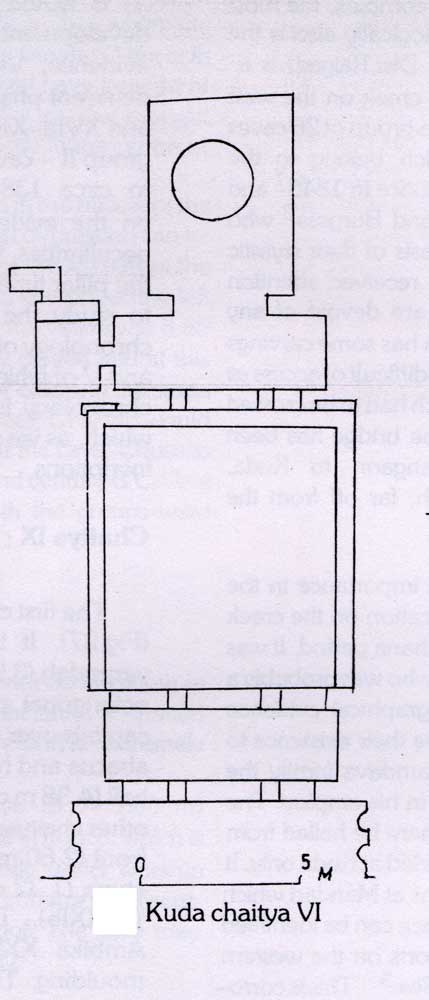
Fig.11. Kuda 6, chaitya, plan
Considerable development took place at Kuda. Chaitya 9 is a quadrangular chamber with a stupa. It has a veranda with a cell with a bench on the left. Cave 15 is identical and has a room each at either end of the veranda. Chaitya 1 is like a temple with a veranda, a hall and a shrine joined to it by a vestibule (antarala). The development is complete in Chaitya 6 with the addition of benches on three sides of the hall (Figure 11). Cave 4 is similar but incomplete. The Kuda epigraphs end in deya-dhamma, the Hinayana formula.
Mahad
Small, modest caves combining chaitya and vihara were thus coming up in the interior of Maharashtra most of which have remained unfinished for want of adequate patronage. At Kanheri, however, the art activity continued possibly because of patronage available in the neighbouring commercial centres such as Sopara, Kalyan, and Chaul. Among the architectural experiments that were underway in the post-Satavahana era, the most remarkable is that at Mahad, an ancient trading centre on the Mumbai-Goa highway. In its group of 28 caves, Nos. 1 and 8, both chaityas, are noteworthy (Figures 12-13). They can be said to be the link between the Hinayana and the Mahayana caves at Ajanta as they bear striking resemblance with Ajanta 8 (Figure 14) and 11 (Figure 15) respectively. Of the two, Mahad 8 (Figure 12), which is well planned, consists of a square hall (4.50 m sq.) with benches on three sides and a shrine in the rear wall, flanked by a cell with bench. The veranda is ruined but its pillars have survived; they have square bases and are ornamented with lotus medallions. The bell capital has stepped abacus above like that at Kuda. The shrine once contained a rock-cut stupa as the circular mark on the floor and the chhatra in the ceiling indicate, but is now completely destroyed.
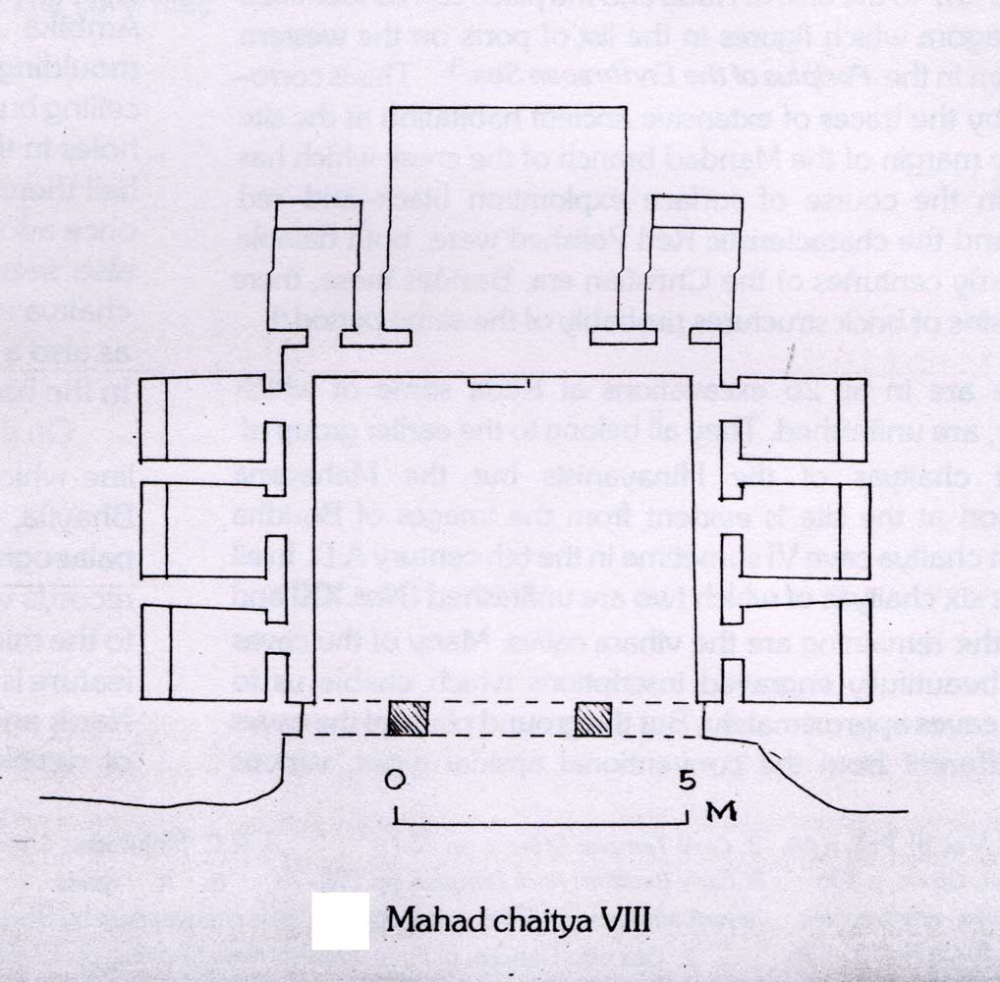
Fig.12. Mahad 8, plan

Fig.13. Mahad 1, plan
An inscription on the back wall of the hall states that the chaitya-griha, eight cells and two cisterns are the gift of Prince Kanahboa Vanupalita. The record conforms to the Hinayana formula – deya-dhamma. I would place it in the latter half of the third century although Nagaraju assigns it to 90 AD (Nagaraju 1981) and Dehejia to 100 AD (Dehejia 1972, 182-88).

Fig.14. Ajanta 8, plan
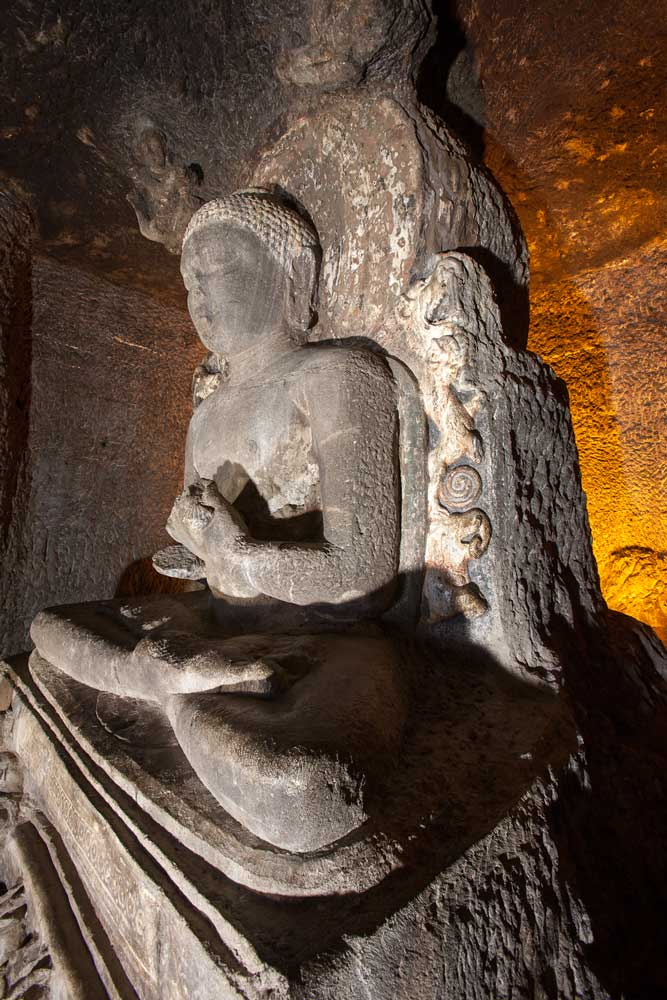
Fig.15. Ajanta cave 11, Buddha image and the stupa in the shrine
Mahad chaitya 1 (Figure 13) is probably later than No 8 (Figure 12) and is problematic. It consists of a quadrangular hall (17.54 x 10.52, 3.20 m high) with a pillared veranda and a square shrine in the back wall. The hall has four cells in the left wall and four more in the rear wall, all unfinished, besides two each flanking the shrine chamber. It also has a running bench on all four sides. The shrine chamber (6.10 x 5.19 m) has two pillars, one each on both sides, and an entrance flanked by a large window as in Kuda chaitya 6 (Figure 11). Inside there is a square mass of rock from which an attempt seems to have been made to carve out a stupa, but what we see at the front is a Buddha image in the pralamba-pada mudra as in Ajanta 26 and in Ellora 10. On the throne below is the dharma-chakra and deer, male attendants with fly whisk flank Buddha and Vidyadharas hovering above in the sky. At the top is a makara-torana with flying figures holding a crown. Unfortunately the face, the chest and the abdomen of Buddha have been scooped out.
On the back of the rock mass has been carved an outline of a seated Buddha and on the left face of the rock is Vajrapani who has a stupa in his crown whereas on the right face is Padmapani. All this imagery belongs to the fifth-sixth century, which is betoken of the domination of the Mahayanists.
The cave appears to be a late excavation of the late third or early fourth century, including the rock mass intended for a stupa and possibly the Buddha figure at the front; the other imagery is later. According to Vidya Dehejia and Nagaraju, it is a Mahayana chaitya and hence they have not included it in their studies. Burgess also does not say anything about its religious affiliation obviously because of the images of Buddha and Bodhisattvas in the shrine.
Ajanta 8
This cave (Figure 14) is absolutely unknown even to the scholarly world as it is completely in ruins and is used for housing generators supplying power to the site. According to Burgess it was a Hinayana excavation (Fergusson and Burgess 1880, 289) but the late Dr Suresh Vasant meticulously studied it and prepared its plan from whatever remains of it and assigned it to the Mahayana group at the site (Jadhav 1987). The cave consists of a hall (7.60 m sq., 3.5 m high) with three roughly square cells in side walls and two each flanking the shrine which has a bench or a platform in the rear wall. There are some early features in the cave such as its plan which is identical with Mahad 8 (Figure 12), and holes in the platform/bench in the shrine for fixing a loose image (of Buddha) which, as we have shown was already in vogue at Kanheri earlier. The veranda is totally ruined. The cave shares many features with Mahad, Kuda and Kanheri and may be assigned to the late third or early fourth century.
Ajanta 11
This cave (Figure 15) is most crucial as it forms the link between the Hinayana and the Mahayana groups. Even Walter Spink is of the opinion that it is the earliest in the later group (W. M. Spink 1968). It has some early and some late features. It consists of a hall with a veranda at the front and a shrine in the rear wall. The veranda pillars have square bases, but the shafts are octagonal with bracket capitals. At both ends of the veranda is a cell and its right wall is carved with three panels showing Buddha figures. The hall is supported by four pillars with moulded bases and octagonal shafts which are crowned by ghata-pallava capitals. There are three cells each in the back and left walls and a bench along the right wall as at Junnar, Kanheri and other sites. The shrine contains a Buddha image in teaching attitude; it is carved against an unfinished stupa; the image is also unfinished and recalls that in Mahad 1 (Figure 13) which further develops in chaitya 19 and 26 at Ajanta.
There is a painted inscription in the cave which can be palaeographically assigned to the latter half of the fifth century. However, Spink has shown that there are two phases of painting in the cave and dates the cave to mid-fifth century.
Conclusion
The foregoing analysis of evidence available at Junnar, Kanheri and some of the minor cave sites indicates the transition between the Hinayana and the Mahayana caves during 200-450 AD. In fact the beginning was made at Ajanta 9 (Figure 4) where an apsidal chaitya is found in a quadrangular hall, developing in course of time in Ajanta 19 and 26 which represent the culmination of the idea of having both the image and stupa together as at Nagarjunikonda where in some of the Ikshvaku viharas there are two shrines side by side, one for stupa and the other for the Buddha image (S. Dutt 1965, 191). They were separated obviously because they were worshipped by to two different sects viz. the Hinayana and the Mahayana respectively. An attempt was made to combine them in Mahad 1 (Figure 13) as also in Ajanta 11 (Figure 15) and 1, and perfected in Ajanta 19 (Figure 3) and 26 as also in Ellora 10. This clearly suggests that both the Hinayanists and the Mahayanists were living together amicably in Maharashtra. When Yuan Chwang visited Konkanapura (Konkan, Western India), he found a hundred sangharamas and about ten thousand bhikkhus, including Theravadins and Mahayanists, living together, and later I-Tsing noted that the Mahayanists worshipped Bodhisattva and read Mahayana sutras, and those who do not read, are Hinayanists (B. G. Gokhale 1976, 98-99). This would suggest that the Hinayanists may not have been worshipping the Buddha image in the initial stages and hence the two small Buddha images were carved in low relief on the massive pillar in the forecourt.
The image worship in Buddhism has rightly been credited to the Mahayanists as also that of Avalokiteshvara, Manushi Buddhas and Tara which are all present in the later group at Ajanta, besides Avalokiteshvara’s litany. Manushi Buddhas are depicted in Caves 1, 2, 7, and 26 in stone and paint. It should be noted that the Mahayana donative formula of inscriptions, as for instance in Ajanta 26, which suggests the sharing of the merit achieved, certainly points to the presence of Mahayanists at Ajanta and shows that adherents of both the sects were living together. The only conclusion that we can draw is that neither of the sects was dominant at Ajanta which could be said to represent the overlapping phase between the Hinayana and the Mahayana. The earliest influence of the Mahayana is discernible at Junnar and Kanheri in donative records, and the Buddha images in Kanheri chaitya 3 which, however, appear to have been executed rather surreptitiously. The attempt to carve out the Buddha image on the rock cut stupa in the shrine at Mahad is noteworthy. The Mahayanists appear to have succeeded in Mahad Cave 1 where there is a Buddha image in the shrine and on the back of the rock mass is an outline of a seated Buddha with Padmapani on the right face and Vajrapani on the left face. This belongs to the fifth century when the Mahayanists become dominant as is supported by the evidence from Ajanta, particularly Caves 19 and 26 where there are images of Buddha, Bodhisattva, Avalokiteshvara, Tara and even Manushi Buddhas which may have provided the inspiration for the donor of Mahad 1. Spink has assigned most of the important Mahayana caves at Ajanta to 460-480 AD and has classified them at Mahayanist.
Captions
Fig. 1 Kanheri chaitya cave 3, forecourt: Buddha figures on the pillar
Fig. 2 Kanheri cave 41, eleven headed Bodhisattva
Fig. 3 Ajanta chaitya 19, hall with Buddha image and the stupa (photo: R.K. Singh, courtesy of ASI)
Fig. 4 Ajanta 9, plan (source: Fergusson and Burgess 1880, plate XXVIII)
Fig. 5 Junnar Ganesh Leni 14, plan (source: Dhavalikar 1984, fig. 13)
Fig. 6 Junnar Shivaneri East, 25, plan (source: Dhavalikar 1984, fig. 63)
Fig. 7 Kanheri 21, plan (source: Dhavalikar 1984, fig. 39)
Fig. 8 Kanheri 32, plan (source: Dhavalikar 1984, fig. 42)
Fig. 9 Kanheri cave 50, niche in the rear wall
Fig. 10 Kanheri 50, plan (source: Dhavalikar 1984, fig. 44)
Fig. 11 Kuda 6, chaitya, plan (source: Dhavalikar 1984, fig. 30)
Fig. 12 Mahad 8, plan (source: Dhavalikar 1984, fig. 32)
Fig. 13 Mahad 1, plan (source: Dhavalikar 1984, fig. 33)
Fig. 14 Ajanta 8, plan (source: Dhavalikar 1984, fig. 36)
Fig. 15 Ajanta cave 11, Buddha image and the stupa in the shrine (photo: R.K. Singh, courtesy of ASI)
References
Burgess, Jas. 1883. Report on the Buddhist Cave Temples and their Inscriptions, Archaeological Survey of Western India series. Vol. IV. London: Trubner & Co., Ludgate Hill.
Coomaraswamy, A.K. 1956. Buddha and the Gospel of Buddhism. Bombay: Asia Publishing House.
Dehejia, Vidya. 1972. Early Buddhist Rock Temples: A Chronological Study. London: Thames and Hudson.
Dhavalikar, M.K. 2002. Environment and Culture: A Historical Perspective, Research Unit series. Poona: Bhandarkar Oriental Research Institute.
———. In press. Kanheri: A Rediscovery. Mumbai.
———. 1984. Late Hinayana Caves of Western India. Poona: Deccan College Postgraduate and Research Institute.
Dutt, Nalinaksha. 1988. Mahayana Buddhism. Delhi: Motilal Banarasidass Publishers.
Dutt, Sukumar. 1965. Buddhist Monks and Monasteries of India: Their History and their Contribution to Indian Culture. Delhi: Motilal Banarasidass Publishers.
Fergusson, James, and James Burgess. 1880. The Cave Temples of India. London: W.H. Allen.
Gokhale, B.G. 1976. Buddhism in Maharashtra: A History. Reprint. Bombay: Popular Prakashan.
Gokhale, Shobhana. 1991. Kanheri Inscriptions. Pune: Deccan College Post Graduate and Research Institute.
Jadhav, Suresh Vasant. 1987. Ajanta Cave VIII: A Study. Vol. II, in Kusumāñjali: New Interpretation of Indian Art & Culture; Sh. C. Sivaramamurti Commemoration, ed. M.S. Nagaraja Rao, 249–54. Delhi: Agam Kala Prakashan.
Jadhav, Suresh Vasant. 1980. Rock-cut Cave Temples at Junnar: An Integrated Study. PhD thesis. Pune: University of Poona.
Leese, Marilyn. 1979. 'Early Buddhist Icons in Kanheri Caves'. Artibus Asiae 41:83–93.
Meister, Michael W. 1981. 'Suburban Planning and Rock-cut Architecture of India'. In Madhu, Recent Researches in Indian Archaeology and Art History, Shri M.N. Deshpande Festschrift, ed. M.S. Nagaraja Rao, 157–164. Delhi: Agam Kala Prakashan.
Nagaraju, S. 1981. Buddhist Architecture of Western India, c. 250 B.C. – c. A.D. 300. Delhi: Agam Kala Prakashan.
Sankalia, H.D. 1986. 'A Unique Wooden Idol of the Buddhist Goddess Tara from the Kanheri Hills.” Journal of the Asiatic Society of Bombay 56–59:296–99.
Schlingloff, Dieter. 2013. Ajanta: Handbook of the Paintings. Three volumes. New Delhi: IGNCA and Aryan Books International.
Schopen, Gregory. 2004. Mahayana. Encyclopaedia of Buddhism, vol. 2, ed. Robert E. Buswell, pp. 492–99. New York: Macmillan. Online at http://terebess.hu/zen/szoto/EncBuddh.pdf (viewed on June 18, 2016).
Sharma, R.S. 1987. Urban Decay in India (c. 300–c. 1000). New Delhi: Munshiram Manoharlal Publishers.
Singh, Rajesh Kumar. 2012. An Introduction to the Ajanta Caves: With Examples of Six Caves. Baroda: Hari Sena Press.
Spink, Walter M. 2005–14. Ajanta: History and Development series. Ed. J. Bronkhorst. Seven volumes. Lieden: Brill.
———.1964. 'History from Art History: Monuments of the Deccan'. In Summaries of Papers, Organising Committee [of the] 26th International Congress of Orientalists, New Delhi, India, ed. R.N. Dandekar, 242–43. New Delhi.
———.1968. 'Ajanta's Chronology: The Problem of Cave Eleven'. Ars Orientalis 7:155–68.
———. 1974. 'The Splendours of Indra’s Crown: A Study of Mahayana Developments at Ajanta'. Journal of the Royal Society of Arts 122.5219:743–67.
Takakasu, J., trans. 1966[1896]. A Record of the Buddhist Religion as Practised in India and the Malay Archipelago (AD 671–695) by I-Tsing. Oxford: Clarendon Press. Delhi: Munshiram Manoharlal.
[1] The most exhaustive study of Ajanta and Western Indian cave temples is that by Professor Walter M. Spink. He has published many papers on Ajanta which have recently been published in six massive volumes (Spink 2005–14). His first long paper on Ajanta outlining his views in detail was presented at the 34th International Congress of Orientalists in January 1964 (Spink 1964). For his later views, see Spink 1974.
[4] For an excellent survey of the Junnar complex, see Jadhav 1980.
